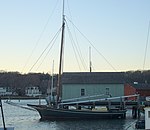Mystic station (Connecticut)

Mystic station is an intercity train station on the Northeast Corridor, located off Roosevelt Avenue (US 1) east of downtown Mystic, Connecticut. It is served by a limited number of trains on Amtrak's Northeast Regional service, with three to five daily trains in each direction. Amtrak's Acela also passes by this station, but does not stop. Mystic is one of only three stations on the Northeast Corridor (along with adjacent stations Westerly and Kingston to the north) to be served exclusively by Amtrak, with no commuter rail service. The first Mystic station opened in 1858; it burned down and was replaced in 1866. The current station building was built in 1905. A classic small American train station, it was used as the model for American Flyer model stations for over 50 years. The station only has low platforms, unlike most Amtrak stations on the Northeast Corridor; however, a wheelchair lift is available for accessibility. The station building is used as a coffee shop and passenger waiting area.
Excerpt from the Wikipedia article Mystic station (Connecticut) (License: CC BY-SA 3.0, Authors, Images).Mystic station (Connecticut)
Roosevelt Avenue,
Geographical coordinates (GPS) Address Nearby Places Show on map
Geographical coordinates (GPS)
| Latitude | Longitude |
|---|---|
| N 41.3509 ° | E -71.9632 ° |
Address
Roosevelt Avenue 2
06378
United States
Open on Google Maps









